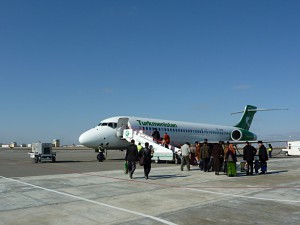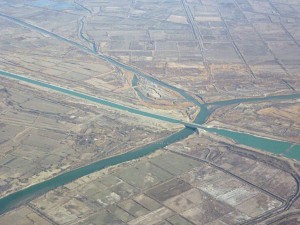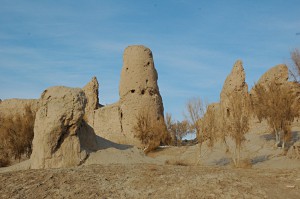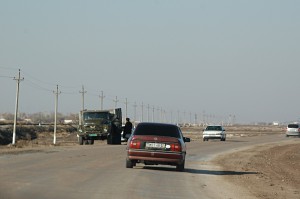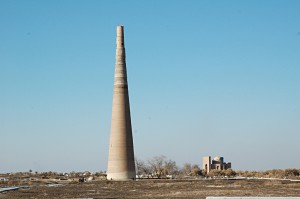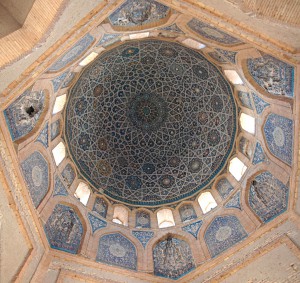The trip from Mary to Dashoguz was hopefully the one and only time I took the airplane during this trip. The flight leads across the Karakum desert to the North-East of Turkmenistan, where a large source of income is agriculture. The region was also an important trading center during the time of the silk road, connecting to current day Russia, Iran and Uzbekistan.
When I looked out of the window on Sunday morning I was mildly surprised: it was to be the first time in Turkmenistan with sun! My official program foresaw the flight from Mary to Dashoguz. I only was picked up at the hotel at 11:45am such hat I had time for a short walk to the Internet Cafй to update my blog.
The flight itself was not very surprising at all, just regular flight. Still there were a few unexpected scenes before and after the flight. For example the airport in Mary consists of one terminal, one check-in counter, one gate, two security controls and two runways. Once more I got the impression that the requisite for a uniformed position in Turkmenistan is a particularly grimm face and a good share of distrust. My luggage, passport and ticket were checked when I entered the gate as well as when entering the gate area. But besides taking a little bit of time there were no inconviences.
Everybody knew when it was boarding time, when a door towards the parking area of the airplanes opened and we could walk to the airplane. The correct airplane was easy to find, since there was only one on the whole airport. From Mary there are two flights a week to Dashoguz and three fligts a day to Ashgabat.
The flight led from Mary in the South of Turkmenistan across the Karakum desert to Dashoguz in the North-East of the country. From the airplane one could very well see the irrigation systems near Dashoguz, which are part of the reason why the lake Aral is drying up. The provinces Dashoguz and Lebab on the border to Uzbekistan are the two most intensively used areas as far as agriculture is concerned. The main source for water is the Amu-Darya river which snakes along the border to Uzbekistan and until a few years ago still fed lake Aral.
When I got off the airplane I wanted to take a picture of the nice terminal of Dashoguz. But once again I got the indication that this is forbidden. Too bad, since next to the terminal around 20 Antonov An-2 aircrafts in Turkmen colors are parked.
Inside the terminal building I met Veyis, my driver for the two days to come. He helped me with retrieving my luggage from baggage claim. Not an easy feat, since the luggage was dropped from a conveyer belt onto a platform of about 4 square meters. Of course all the people were pushing to this platform and the ones whos luggage arrived last were standing in the front row. Eventually my backpack arrived and after clearing control that I had the matching ticket for the luggage I was cleared and we could leave the terminal building.
Veyis and I immediately made our way to the first sight in Dashoguz. Since it is not far from the airport, we visited the fortress of Izmikshir about 25km to the South-West of Dashoguz. The fortress is about 2000 years old and its walls, once about 20 meters tall, still stand proudly. The ruin seems to be kept really well, since there are official parking lots and walking paths around. Veyis handed me a magazine of the State Committee for Tourism and Sport with a lengthy article about the fortress, which he originally had written when he was still director of tourism in Dashoguz. In the meantime he has been retired for 2 years and occasionally gives tourists a ride around the area. With my broken Russian, we managed to exchange a few informations about each other, so I learned that Veyis has two daughters, two sons and six grand-children.
On the way back we took the route through small villages which are all about agriculture. The found the idea of storing straw on the rooftops quite intriguing. The area is very dry and a little humidity will soon evaporate once the sun comes out again. No additional buildings are required. On our tour we also drove through the city center of Dashoguz. As in Mary, some main buildings have been recently rebuilt in marble. The hotel unfortunately lies quite a distance from the center, but at least there are a few restaurants around. The bazaar on the otherside of the street uniquely sells spare parts for cars.
On Monday we visited the city of Konye-Urgench, meaning old Urgench. In the 11th and 12th century a city of more than a million inhabitants it today has a mere 40’000 people living there. The “new” Urgench lies further East across the border in Uzbekistan. The destruction and change of the Amu-Darya river made the people establish a new city in that place.
Since winter is slowly coming, I wanted to buy a hat before we left in the bazaar opposite the hotel. I met Aziz, the guide for the day at the hotel, and told him I would be back soon, I just wanted to go to the bazaar quickly.
This was when I learned that this bazaar only offered spare parts for cars. Similar to Iran, there are bazaars for all types of goods in Turkmenistan. Aziz of course was a little bit surprised that I wanted to go shopping in such a bazaar and wondered what kind of spare parts I needed. I explained him my intension and he told me that the main bazaar of Dashoguz was closed due to cleaning, but that there was another smaller place where we could find a hat. There I finally found an original Adidas hat for US$3.
My second goal for the day was to change a few US dollars into Uzbek som to be prepared for the following day when entering Uzbekistan. We found a dealer at a street corner. He was not quite amused when he saw my old 20 Dollar bill, but finally took it anyway, when I showed him that this was the only bill I had. This was a nice trick to get rid of the old 20 Dollar bill I had gotten in Iran when changing Rials back to Dollars. In return I received a pile of 45 bills of 1000 som each, apparently the largest bill there is in Uzbekistan.
Once all my commercial activities were completed, we took off to Konye-Urgench, about 90km North-West of Dashoguz. On the way I tried to get as much information from Aziz about himself and Turkmenistan as possible. He is an English teacher who occasionally, especially in spring, tours with tourists around Dashoguz and Konye-Urgench.
Just before midday, we reached our destination. Not much is left of the original fortress. This is why a visit to the history and ethnography museum is worth the trip, since they have a model of the former city walls and todays remains. Thoe remains are a few mausoleums, a city gate and the highest minaret in Central Asia of 64m of height. On our trip we visite the mausoleum of Najmeddin Kurba, the museum, the city gate with the carawanserei, the mausoleum of Arslan, the mausoleum of Tekesh under whom the city was most glorious in the 12th century and the minaret of Gutlug Timur.
Just like in the ancient Merv we met a few local people who were pilgrims visiting the mausoleums and walking around them three times while praying. One very special sight however was the hill next to the minaret. On older man was foreseeing people’s future. He did this by letting them dress in a long manteau and let them roll down the hill. Depending on whether one rolls straight, left or right there is a different future in store. I was not interested enough in my future to try this myself, but watched a couple of people doing that. On the same hill there were two more sights to see: a place where women wish for children and another one where people build small stone tower for wishes.
Finally we visited the mausoleum of Tekesh’s wife. Tekesh wanted to build the most beautiful palace for his wave. This palace later became her mausoleum. To still there original frescoes from the 14th century can be seen. They symbolize the year consisting of 365 geometrical forms. Below the cupola, there are 12 small windows, one for each month. Below these there are 4 small windows signifying the four weeks in a month and 4 large windows signifying the 4 seasons.
Once we had seen the last mausoleum, Aziz asked me whether I wanted to head directly back to Dashoguz or whether we should eat lunch in Konye-Urgench. I opted for the second, since I didn’t want to return to Dashoguz that quickly. So we found a cafй nearby where I tried some Russian food. Manti is similar to ravioli, bags made of dough filled with minced meat cooked in hot water. The sauce consists of sour cream.
Once our stomachs were filled we drove the 90 minutes back to Dashoguz. As on the trip to Konye-Urgench I could observe a small ritual performed by Veyis and Aziz at each police control point. Wearing seat belt is mandatory, but the law has not yet become the habit of the people, such that the don’t wear seat belts. The just make it seem as if they were wearing seat belts whenever the spot a police man on the roadside. Just when the control point is passed the let go of the seat belt again. At one point we were stopped after all. But Veyis just showed them his papers and as a former government official he could pass. The seat belt was not part of the discussion, since neither Veyis nor Aziz was wearing a seat belt when we were stopped. On our continuing drive Veyis warned all the oncoming cars by raising his left index finger which was acknowledged by the drivers with a quick nod.
Back at the hotel we made sure I had a ride the following morning to the border of Uzbekistan. I was looking forward to traveling on my own again. I see different advantages and disadvantages when traveling in this organized way. Advantages are certainly the ease of travel, one does not need to worry about accomodation or transport. One also has an English-speaking local guide whereever one is going, with the disadvantage in Turkmenistan that the guide will not give all the information since he might not be allowed to. Another disadvantage in my opinion is the fact that one cannot really get under the skin of a foreign country. Admitedly I had a few hours here and there which I could spend on my own. Due to the sheer size of the cities in Turkmenistan and my fault in not bringing a guide book, as well as my few encounters with people telling my what I wasn’t allowed to do, took my enthusiasm to do more here. For a similar trip in the future i would opt for the 5-day transit visa, since the relation of price to what I was being offered did not meet my expectations. But this is what traveling is for. Learning about other countries.

